If you have a backyard garden, you’ve come across different types of green caterpillars. Identifying these crawling insects can be a daunting experience for beginners and season gardening enthusiasts.
The scientific name, diet, defense mechanisms, and final growth stage are crucial elements of the green caterpillar identification guide. Some green caterpillars may turn into butterflies and others into moths.
Most green caterpillar species are harmless since they have smooth bodies. But some species have spikes or spines that give nasty stings. In this article, we have explained tips for identifying these caterpillars and handling them.
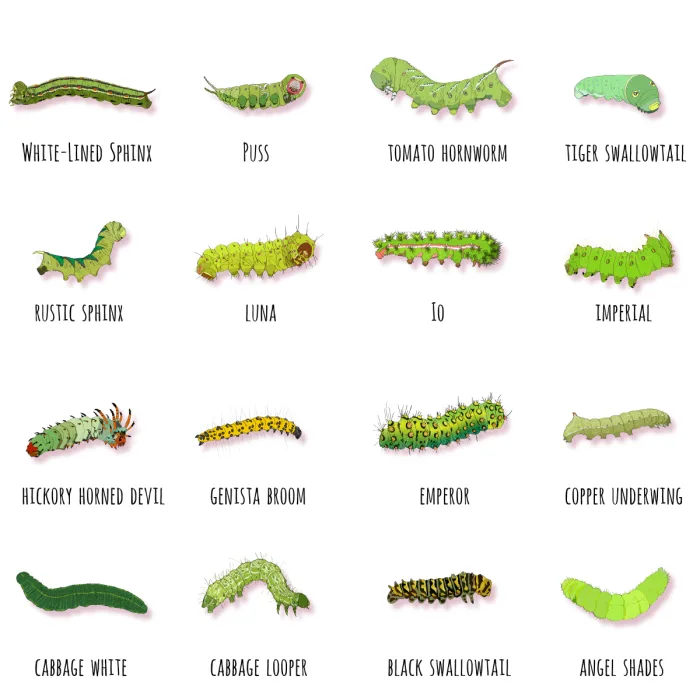
How to Identify Green Caterpillars (Step-by-Step)
All caterpillar types go through different stages of growth. Baby larvae of green caterpillars are different from their mature counterparts. Here are quick tips for identifying green caterpillars:
Diet
Most green caterpillar species pose little threat or damage to plants. But every species feed on different plants and trees.
Sting
These caterpillar species are harmless to humans since they have smooth bodies. But some green caterpillar species have spines that can cause nasty stings.
Popularity
Green caterpillars are common in backyard gardens with trees and vegetables during the early spring. They chew leaves and cause severe harm to the lovely plants in your garden.
Effect on Plants
These caterpillar species do little to no damage to crops and trees. But a few pest species may destroy your vegetable garden and backyard trees during the early spring.
Final Growth Stage
Caterpillars are the larval stages of butterflies and moths. Green caterpillars turn into winged adults with beautiful colors.
Types of Green Caterpillars with Names and Pictures
Here is a guide to help you identify different green caterpillar types in your backyard garden. (Source: University of Missouri). Take the time to read through and learn tips for handling them without hurting yourself:
Fall Webworm
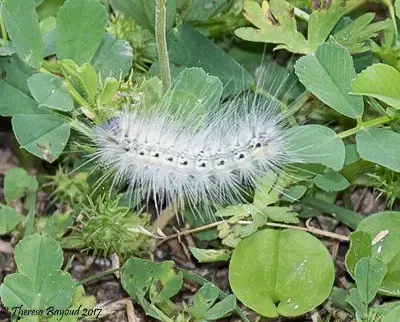
Greenish-bodied fall webworm caterpillars are native to warmer climates. These caterpillar species spin large webs around the host plants.
Fall webworm caterpillars also come in pale yellow with black dots and dark gray with light markings. The small fuzzy caterpillars also survive in cold climates.
Greenish-bodied fall webworms feed on leaves from cherry, walnut, crabapple, and other deciduous trees. Web-like structures on plants make it easier to identify them.
| Scientific Name | Hyphantria cunea |
| What Do They Eat | Leaves on walnut, cherry, and crabapple |
| Maximum Growth Size | 2.5cm long |
| Is It Harmful to Humans | Poisonous spines can cause pain. |
| What Do They Turn Into | Pale-yellow moths with blue eye spots on wings. |
| Identification Feature | Long yellow or white hairs grow from orange-red tubercles. |
Polyphemus Moth Caterpillar
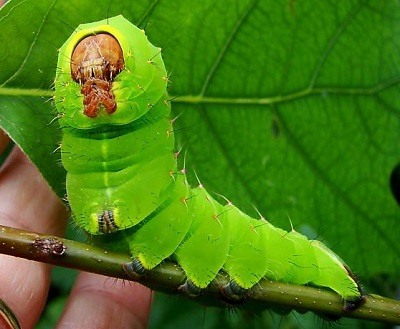
It is a green caterpillar type with a bright green body and a reddish head. The older instars are yellow-green with setae becoming less prominent with each molt. These caterpillar species feed on grapes, willow, rose, birch, and maple. (Source: University of Florida).
| Scientific Name | Antheraea polyphemus |
| What Do They Eat | Grapes, willow, maple, rose, birch |
| Maximum Growth Size | 2.5-3cm |
| Is It Harmful to Humans | Harmless |
| What Do They Turn Into | Polyphemus Moth |
| Identification Features | Bright-green body and a reddish brown head |
Emperor Moth Caterpillar
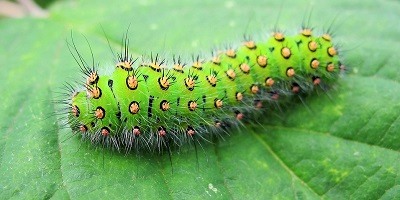
It is one of the largest green caterpillar species in the Saturniidae family. The juvenile emperor moth caterpillar is black and orange, while the mature counterpart turns green with black rings featuring orange and yellow spots around the segment.
The tiny black hairs are non-poisonous though they can cause skin irritation. The row of yellow spots wrapping each segment is the most conspicuous feature. They feed on blackthorn and hawthorn.
| Scientific Name | Saturnia pavonia |
| What Do They Eat | Blackthorn, hazel, bramble, and sallow |
| Maximum Growth Size | 1-2cm |
| Is It Harmful to Humans | Skin irritation effects from the spines |
| What They Turn Into | Small emperor moth |
| Identification Features | Large plump green caterpillar with rows of yellow dots around each segment |
Copper Underwing Moth Caterpillar
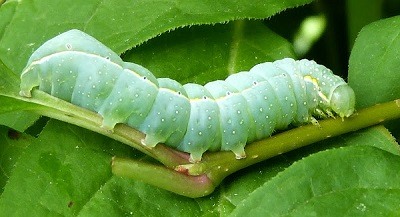
It is a chubby-looking green caterpillar with a translucent pale green body during the early stages. A mature copper underwing caterpillar is dark green with yellow stripes along its sides.
The pointed humped rear end and colored horn-like tip are the features for easy identification of this hornworm type. It also has four pairs of abdominal prolegs and three pairs of frontal legs.
| Scientific Name | Amphipyra pyramidea |
| What Do They Eat | Maple, oak, grapes, and raspberry |
| Maximum Growth Size | 2.5cm |
| Is It Harmful to Humans | Harmless |
| What They Turn Into | Copper underwing moth |
| Identification Features | Chubby-looking with yellow-white stripes along its sides and a pointed humped rear end. |
Luna Moth Caterpillar
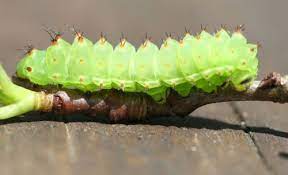
It is among the largest green caterpillar species with a spiky pale green body. It also has some segments forming ridges on the smooth body. The luna moth caterpillars have orange or yellow spots with sprouting small fine black spines.
The spikes do not sting, although it causes skin irritations after coming into contact. It later becomes a reddish-brown luna moth after completing metamorphosis. These caterpillars feed on walnuts, hickories, pecans, and raspberries.
| Scientific Name | Actias luna |
| What Do They Eat | Walnuts, pecans, hickories, and sumacs |
| Maximum Growth Size | 6.5cm long |
| Is It Harmful to Humans | Causes skin irritation |
| What They Turn Into | Luna moth |
| Identification Features | Unusual green caterpillar due to its vibrant colors and size. |
Cabbage White Butterfly Caterpillar
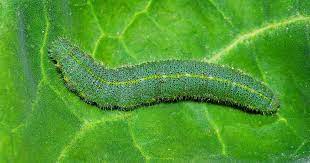
It is the most popular green caterpillar type due to its light green colors. Besides that, it can be challenging to spot the cabbages, kales, and broccoli leaves since they camouflage well.
The cabbage white caterpillar has a huge appetite making it more destructive to crops and other vegetables in the garden. The bluish-green bodies with tiny black dots on the segments are conspicuous.
| Scientific Name | Pieris rapae |
| What Do They Eat | Cabbage, kale, broccoli leaves |
| Maximum Growth Size | 3.5cm long |
| Is It Harmful to Humans | Harmless |
| What They Turn Into | Cabbage white butterfly |
| Identification Features | A juvenile larva has a black head that gradually turns yellow and finally green in each instar. |
Winter Moth Caterpillar

It is a type of Inchworm species and belongs to the Geometridae family. The inchworm’s name comes from its average body size (an inch long). Winter moth caterpillars are invasive but beneficial insects.
Less destructive winter moth caterpillars have more legs at their rear. Invasive species have two legs on their ends. They feed on leaves of oak, maple, beech, raspberry, willow, and blueberry.
| Scientific Name | Operophtera brumata |
| What Do They Eat | Leaves of Oak, Maple, Beech, and Willow |
| Maximum Growth Size | 2.5 cm long |
| Is It Harmful to Humans | Causes skin irritation or rashes when touched. |
| What They Turn Into | Greyish brown moth |
| Identification Features | Tiny slender green inchworm |
Rustic Sphinx Moth Caterpillar

It is a green-horned caterpillar native to Texas, Florida, Mississippi, and South Carolina. It has a lime-green body with distinctive diagonal white stripes and maroon dots on its sides.
The large spiky horn does not sting rendering the caterpillar species harmless to human beings. The back top is reddish with diagonal white stripes dividing the green color from the lower segment.
| Scientific Name | Manduca rustica |
| What Do They Eat | Thistles and sunflowers |
| Maximum Growth Size | 2-3cm |
| Is It Harmful to Humans | Harmless |
| What They Turn Into | Rustic sphinx moth |
| Identification Features | Large horns and diagonal white stripes |
European Puss Moth Caterpillar
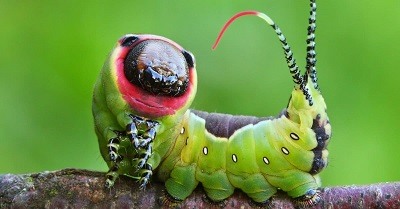
It is a fat-green caterpillar with a triangular head at one end and a long spiky tail at the other. It can extend menacing lashes to ward off insects when feeling threatened. The patterns on the head are scary to scare potential predators.
They spit poisonous acid that can cause skin irritation. They act aggressively and can be confused with American puss caterpillars. European puss caterpillars are not hairy like their American counterparts.
| Scientific Name | Cerura vinula |
| What Do They Eat | Aspen, willow, and sallow |
| Maximum Growth Size | 8cm long |
| Is It Harmful to Humans | Harmful |
| What They Turn Into | Puss Moth |
| Identification Features | A big plump green caterpillar that acts aggressively. |
Cecropia Moth Caterpillar
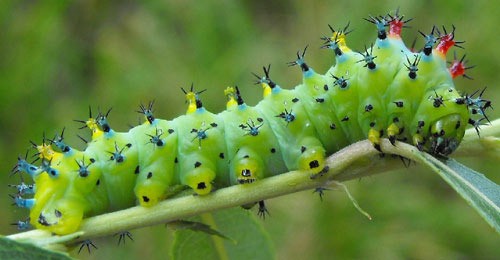
It is the largest green caterpillar species native to North America. The juvenile species is yellowish-green while the mature counterpart is bluish-green. The ridged appearances with yellow, blue, or orange tubercles make these caterpillars recognizable.
The colorful bumps have small black spikes to bring out the bizarre-looking caterpillar. It later turns out into a beautiful moth after a complete metamorphosis. The larvae feed on ashes, alder trees, birch, elm, and maples.
| Scientific Name | Hyalophora cecropia |
| What Do They Eat | Ashes, alder trees, birch, and elm |
| Maximum Growth Size | 10cm long |
| Is It Harmful to Humans | Skin irritation |
| What They Turn Into | Cecropia moth |
| Identification Features | Largest green caterpillar species |
Hackberry Emperor Caterpillar
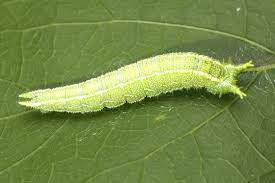
It is a light green caterpillar with two thin yellowish stripes running along the body. The numerous tiny yellow raised dots, dark green head, and two sharp tails make this caterpillar species recognizable.
These caterpillars feed on hackberry leaves and buds during the spring. It later turns brown in the late fall before entering the pupa stage. After a complete metamorphosis, it turns into a stunning brown butterfly with white, brown, and black markings on its wings.
| Scientific Name | Asterocampa celtis |
| What Do They Eat | Hackberry trees |
| Maximum Growth Size | 4cm long |
| Is It Harmful to Humans | Harmless |
| What They Turn Into | Brown hackberry emperor butterfly |
| Identification Features | Green caterpillar with darker head with pale yellow raised dots on the body. |
Green Cloverworm Caterpillar
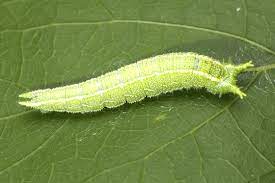
It is a green caterpillar type with a yellowish-green head, thin yellow lines, and pale greenish-white stripes along its sides. It also has three pairs of abdominal prolegs and a pair on the rear.
The squirming behavior makes it easier to identify green clover worms. They have a black snout and are destructive since they feed on soybeans. They have an average size of 2.5-3cm long.
| Scientific Name | Hypena scabra |
| What Do They Eat | Soybeans and other legumes |
| Maximum Growth Size | 2.5-3cm |
| Is It Harmful to Humans | Harmless |
| What They Turn Into | Triangular dark brown moth |
| Identification Features | Segmented bodies are separated with yellow lines. |
Diamondback Moth Caterpillar
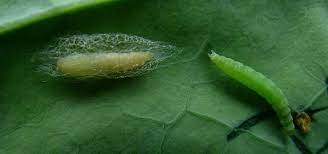
It is a small pale green caterpillar with short black spiny hairs on its body. The body also has small white dots, a tapering rear, and a brown to black head. The five pairs of prolegs and V-shaped rear are the crucial identifying features.
It is also called a cabbage moth caterpillar since it loves munching cabbage leaves, broccoli, and cauliflowers. These caterpillars emerge are colorless when emerging from eggs and later develop into pale green colors.
| Scientific Name | Plutella xylostella |
| What Do They Eat | Cabbage, kales, and weed |
| Maximum Growth Size | 1 cm long |
| Is It Harmful to Humans | Harmless |
| What They Turn Into | Diamondback moth |
| Identification Features | V-shaped rear and dark head. Body covered with short black hairs. |
Lo Moth Caterpillar
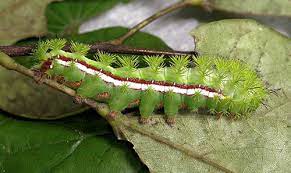
It is a green caterpillar type with a tuft of stinging green spines covering the fat lime-green body. The red and white stripes running along its body make this caterpillar species recognizable.
These green spines contain toxic substances that can cause skin irritation. These toxic stinging spines classify these caterpillars into venomous species. These fat fuzzy green caterpillars turn into orange or yellow moths after pupa stage.
| Scientific Name | Automeris io |
| What Do They Eat | Conifers, deciduous trees, and herbaceous plants. |
| Maximum Growth Size | 6cm long |
| Is It Harmful to Humans | Poisonous |
| What They Turn Into | Orange or yellow moths |
| Identification Features | Tuff of stinging green spines covering the fat lime-green body. |
Tomato Hornworm Caterpillar
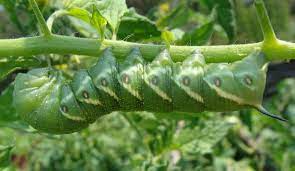
Tomato hornworm caterpillars are the real garden pests giving farmers headaches to control them. These crawling bright green worms or creatures feed on tomato plant leaves and fruits.
Tomato hornworm caterpillars have V-shaped white markings or stripes on their green body. The large head and protruding tail make these caterpillars appear nasty. But they are harmless since they do not sting.
Tobacco hornworm and tomato hornworm caterpillars have close similarities. Both are large and fat green caterpillar species that feed on crops. They are destructive and intimidating to handle.
| Scientific Name | Manduca quinquemaculata. |
| What Do They Eat | Tomato plant leaves and other crops. |
| Maximum Growth Size | 10cm long. |
| Is It Harmful to Humans | Does not sting. |
| What Do They Turn Into | Black grey moth. |
| Identification Features | V-shaped white stripes and dark dots along its sides. |
Cloudless Sulphur Caterpillar
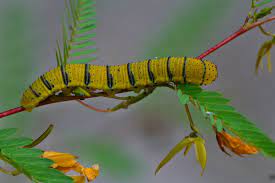
It is a green caterpillar type with yellow stripes and blue or black dots that appear in a row with a close look. Some species have a yellow-green body with bristle-like hairs.
The green foliage diet is the reason for the body color. The yellow-green body color appears when these caterpillars feed on yellow petals. These caterpillars love mulching senna plant leaves.
| Scientific Name | Phoebis sennae |
| What Do They Eat | Senna plants |
| Maximum Growth Size | 4.5cm long |
| Is It Harmful to Humans | Harmful |
| What They Turn Into | Cloudless sulphur butterfly |
| Identification Features | Green body with lateral yellow stripes and a row of blue-black dots. |
Genista Broom Moth Caterpillar
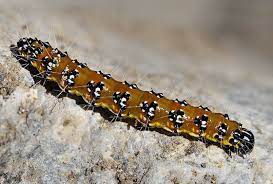
It is a green caterpillar with a black oval head and white dots along its sides as prominent features. These caterpillar species love crawling on sweet peas, honeysuckles, and deciduous plants.
Each segment has white, black, and yellowish markings. They have wispy white spines sticking out from their body despite not being furry types of caterpillars. They are harmless to human beings when handling them.
| Scientific Name | Uresiphita reversails |
| What Do They Eat | Acacia, Brooms, and Texas mountain laurel. |
| Maximum Growth Size | 3.5cm |
| Is It Harmful to Humans | Harmless to humans |
| What They Turn Into | Medium brown moth with dark spots on each top wing. |
| Identification Features | Bright yellow-lime green body color. |
Crown Slug Caterpillar
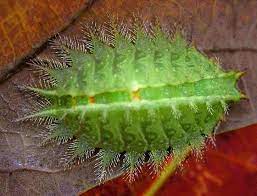
It is a pale-green caterpillar with a flat oval body and stings hairs from its sides. The horns, two lines on the back, and two spiked tails are the identifying features. The stinging spikes are green, yellow, or red.
Crown slug caterpillars grow up to 1.5cm long and can give nasty stings if handled with unprotected hands. The caterpillar species also have ridged back with two pale yellow stripes.
| Scientific Name | Isa textula |
| What Do They Eat | Maple, Oak, elm, hickory, and linden. |
| Maximum Growth Size | 1.5cm long |
| Is It Harmful to Humans | Give nasty stings |
| What They Turn Into | Crowned slug moth |
| Identification Features | Oval pastel green body with plumes of stinging hairs, orange-red horns, and two yellow stripes. |
Oak Slug Caterpillar
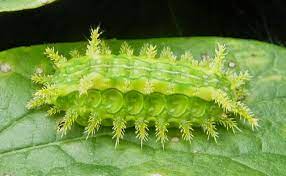
It is a beautiful green oval caterpillar with plumes of stinging spikes, orange lines, and black and white markings. The orange or fuzzy yellow spikes make it easier to identify oak slug caterpillars.
The bright colors are warning signs to stay away from oak slug caterpillars. These caterpillar species can grow up to 2cm long and are harmless to humans. They love chewing deciduous woodland and forest leaves.
| Scientific Name | Euclea delphinii |
| What Do They Eat | Deciduous woodlands and forest leaves. |
| Maximum Growth Size | 2cm long |
| Is It Harmful to Humans | Harmful to humans |
| What They Turn Into | Spiny oak-slug moth |
| Identification Features | Has a green-elongated oval body with two orange stripes and poisonous spines. |
Spicebush Swallowtail Caterpillar
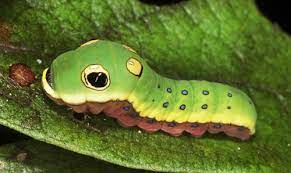
It is a fat green to a yellow caterpillar with bands of bluish-green dots around its segments. The caterpillar has a head with eye-like black and white markings to bring a comical snake appearance.
These plump body caterpillars can grow up to 10cm long with pale green colors and brown undersides. The false eyespots help scare away potential predators when feeling threatened.
| Scientific Name | Papilio Troilus |
| What Do They Eat | Spicebush, sassafras, sweet bay |
| Maximum Growth Size | 10cm long |
| Is It Harmful to Humans | Harmless |
| What They Turn Into | Spicebush swallowtail butterfly |
| Identification Features | Pale green body with ting blue and black dots in a transverse band. |
Tobacco Hornworm Caterpillar
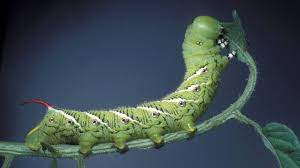
It is a large fat caterpillar with diagonal stripes and black dots. The tobacco hornworm caterpillar also has a green, brown, or orange rear horn with a row of black and yellow dots along its sides.
These caterpillars are harmless to humans though they can damage tomato plants and other nightshade family plants. These tobacco hornworm caterpillars are slightly smaller than tomato hornworms.
| Scientific Name | Manduca sexta |
| What Do They Eat | Tomato plants |
| Maximum Growth Size | 7cm long |
| Is It Harmful to Humans | Harmless |
| What They Turn Into | Carolina sphinx moth |
| Identification Features | Diagonal white and black stripes with tiny black dots having white rings. |
Cross-Striped Cabbage Worm
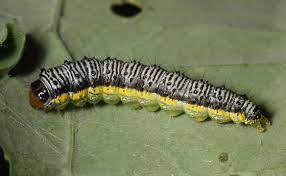
It is a striped green caterpillar with yellow bands, dark green dots, fine hairs, and a round brown head. It is also the most colorful green caterpillar species that changes colors to deep blue or black at maturity.
The stunning fat green caterpillar turns into a tan-colored moth. It grows to about 1.5cm long before entering the pupa stage. The yellow bands, white, and black markings on the greenish-white body are the prominent features.
| Scientific Name | Evergestis rimosalis |
| What Do They Eat | Cabbage leaves |
| Maximum Growth Size | 1.5cm |
| Is It Harmful to Humans | Harmless |
| What They Turn Into | Tan-colored moth |
| Identification Features | Yellow bands along its sides and black dots on each segment |
Rosy Maple Caterpillar
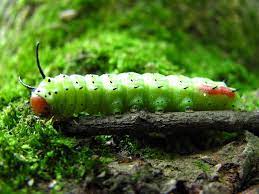
It is a bright neon green caterpillar with stripes, a brown head, bands of black dots, and a pair of black antennae. These caterpillar species change their colors at maturity before entering the pupa stage.
Rosy maple caterpillars develop black spines, bulbous brown heads, and white, green, or back stripes along their length. These plump caterpillars have striped bodies and can grow up to 5cm long.
| Scientific Name | Dryocampa rubicunda |
| What Do They Eat | Foliages on maple trees |
| Maximum Growth Size | 5cm long |
| Is It Harmful to Humans | Harmless |
| What They Turn Into | Rosy maple moth |
| Identification Features | Bright green body with dark longitudinal stripes and two black horns. |
Dragon-Headed Caterpillar
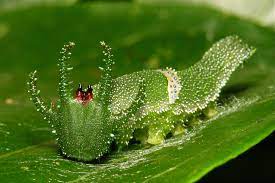
It is a long dark green caterpillar with a large head, scary-looking horns, whitish-yellow lateral stripes, and tiny white dots. These tropical caterpillars are harmless and feed on leguminous plants.
The caterpillar has four pairs of prolegs with each having a white marking. The base of each segment also has white markings and four impressive long horns on the head. Its white stripes and marking are the prominent features.
| Scientific Name | Polyura athamas |
| What Do They Eat | Leguminous plants |
| Maximum Growth Size | 3-30mm |
| Is It Harmful to Humans | Harmless |
| What They Turn Into | Nawab butterfly |
| Identification Features | Longhorns, white strips, and markings on the green body. |
Angle Shades Moth Caterpillar
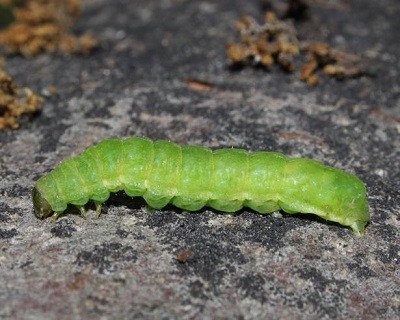
These caterpillar species belong to the Noctuidae family and they are small compared to other green caterpillars. Angle shades caterpillars have dull green with whitish dorsal lines. Some species come in brown or green bodies with red dots along their sides.
| Scientific Name | Phlogophora meticulosa |
| What Do They Eat | Foliages on oaks, birches, and bramble. |
| Maximum Growth Size | 5cm |
| Is It Harmful to Humans | Harmless |
| What They Turn Into | Angle shades moth |
| Identification Features | Dull-green body with dorsal lines |
Imperial Moth Caterpillar
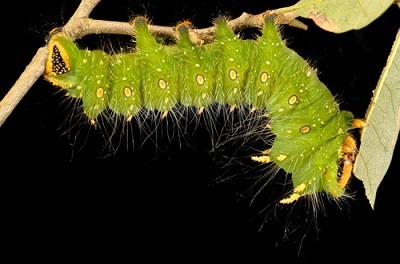
Imperial moth caterpillars come in different colors due to their numerous subspecies in the United States of America. Most of these caterpillar species are non-poisonous and destructive.
These caterpillars can grow up to 10cm long. Large species have green and yellow colors, while the smaller counterparts are brown and burgundy. All these caterpillars can destroy your backyard garden crops.
| Scientific Name | Eacles imperialis |
| What Do They Eat | Garden crops |
| Maximum Growth Size | 10cm |
| Is It Harmful to Humans | Harmless |
| What They Turn Into | Imperial Moth |
| Identification Features | Fat green caterpillars |
Rough Prominent Moth Caterpillar
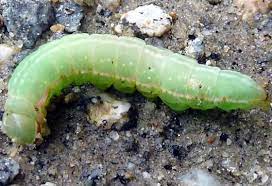
It is a pale-green to a turquoise plump caterpillar with a large, rounded head and tiny black eye-like markings. The numerous yellow speckles, red circular spots on each segment side, and pale-yellow stripes on the sides are conspicuous.
The green caterpillar species also have ball-like translucent heads and can grow up to 1.7cm long. It is also called a white-dotted prominent or green oak caterpillar since it feeds on foliages of birch, alder, maple, and cherry.
| Scientific Name | Nadata gibbosa |
| What Do They Eat | Foliages on birch, alder, maples, and cherry |
| Maximum Growth Size | 1.7cm |
| Is It Harmful to Humans | Harmless |
| What They Turn Into | Rough prominent moth |
| Identification Features | Smooth, fat green segments with yellow speckles. |
Hickory Horned Devil Moth Caterpillar
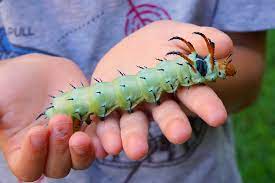
It is the scariest green caterpillar species due to its menacing appearance. The fat segment has long-spiky red horns with black tips and small black spikes. Either end has red tips for easy identification.
It is also the most placid and large species in the Saturniidae family. These evil-looking caterpillars are harmless since they do not sting or bite.
| Scientific Name | Citheronia regalis |
| What Do They Eat | Leaves of hickory trees, willow trees, pecans, and walnuts |
| Maximum Growth Size | 12-14cm |
| Is It Harmful to Humans | Harmless |
| What They Turn Into | Regal moth |
| Identification Features | Largest green caterpillar with horns |
Cabbage Looper Caterpillar
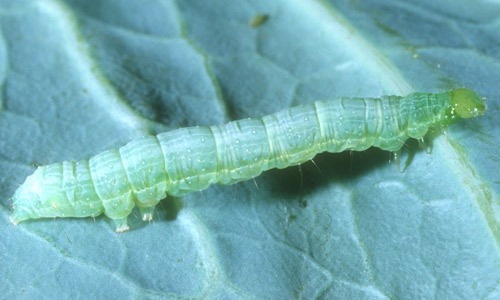
The name comes from its crawling and large arching actions. These caterpillar species are slightly hairy due to the fine spines that grow from their bodies. A mature cabbage looper caterpillar takes the green color and grows up to 4cm long.
| Scientific Name | Trichoplusia ni |
| What Do They Eat | Cabbage leaves |
| Maximum Growth Size | 4cm |
| Is It Harmful to Humans | Harmless |
| What They Turn Into | Cabbage White Butterfly |
| Identification Features | Green body with fine bristles. |
White-lined Sphinx Moth Caterpillar
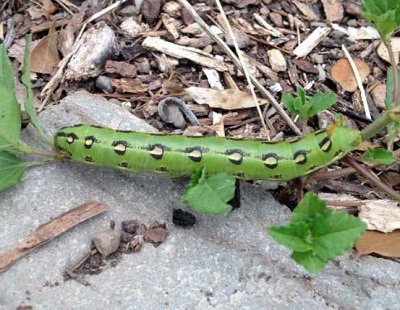
It is a hornworm green caterpillar with a lime-green body having black and yellow markings on its sides. Some large fat caterpillars are black with stripes and others are green with orange or yellow spots.
The horns make these caterpillar species look scary but are ideal as a defense mechanism from predators. The black spots rows with yellow centers are prominent features for identifying white-lined sphinx moth caterpillars.
| Scientific Name | Hyles lineata |
| What Do They Eat | Willow weed, tomato plants, and grapes. |
| Maximum Growth Size | 5-6 cm |
| Is It Harmful to Humans | Harmless |
| What They Turn Into | White-lined sphinx moth |
| Identification Features | An orange and black horn protrudes from the back. |
Tiger Swallowtail Butterfly Caterpillar
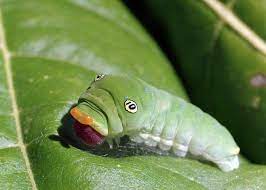
The green tiger swallowtail caterpillar has distinctive markings that keep changing while it grows and matures. These green caterpillars are native to several United States of America regions.
The caterpillar species have yellow or pale green eyespots with black centers resembling human eyes. The white or yellowish bands behind the thorax are the prominent features compared to other green caterpillars.
The scary eyes are ideal for defense mechanisms since they frighten potential predators. The species also emit a foul stench when under threat although they are harmless to humans.
| Scientific Name | Papilio glaucus |
| What Do They Eat | Leaves of wild cherry, birch, tulip, willow, ash, and cottonwood. |
| Maximum Growth Size | 5.5cm |
| Is It Harmful to Humans | Harmless |
| What They Turn Into | Tiger swallowtail butterfly |
| Identification Features | Unusual eye-like markings |
Black Swallowtail Butterfly Caterpillar
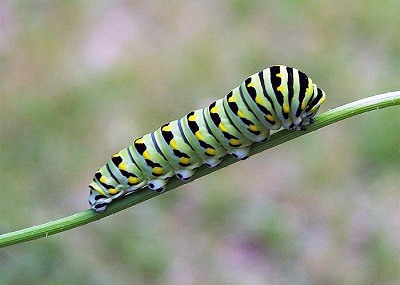
These caterpillar species have lime-green bodies with striking black stripes. Juvenile black swallowtail caterpillars have black bodies that resemble bird droppings. A mature swallowtail caterpillar turns into a pupa and later a beautiful black swallowtail butterfly.
Each segment has black stripes with yellow spots, but the black and yellow lines are close to each other near the head. The caterpillar releases a foul odor and sticks out an orange tongue for defense mechanisms.
| Scientific Name | Papilio polyxenes |
| What Do They Eat | Celery, Parsley, and Carrots |
| Maximum Growth Size | 1.3 to 2.5 cm |
| Is It Harmful to Humans | Harmless |
| What They Turn Into | Black swallowtail butterfly |
| Identification Features | Emit terrible smell and has tiny orange horns. |
People Who Read This Also Read:
